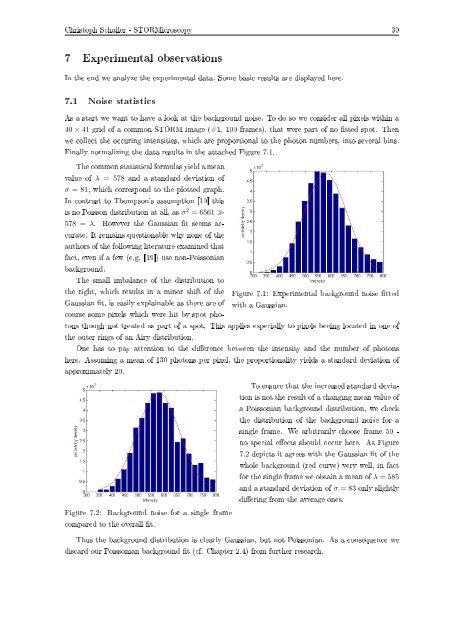Christoph Florian Schaller - FU Berlin, FB MI
Christoph Florian Schaller - FU Berlin, FB MI
Christoph Florian Schaller - FU Berlin, FB MI
Create successful ePaper yourself
Turn your PDF publications into a flip-book with our unique Google optimized e-Paper software.
<strong>Christoph</strong> <strong>Schaller</strong> - STORMicroscopy 30<br />
7 Experimental observations<br />
In the end we analyze the experimental data. Some basic results are displayed here.<br />
7.1 Noise statistics<br />
As a start we want to have a look at the background noise. To do so we consider all pixels within a<br />
40 × 41 grid of a common STORM image (#1, 100 frames), that were part of no tted spot. Then<br />
we collect the occuring intensities, which are proportional to the photon numbers, into several bins.<br />
Finally normalizing the data results in the attached Figure 7.1.<br />
Figure 7.1: Experimental background noise tted<br />
with a Gaussian.<br />
The common statistical formulas yield a mean<br />
value of λ = 578 and a standard deviation of<br />
σ = 81, which correspond to the plotted graph.<br />
In contrast to Thompson's assumption [10] this<br />
is no Poisson distribution at all, as σ 2 = 6561 ≫<br />
578 = λ. However the Gaussian t seems accurate.<br />
It remains questionable why none of the<br />
authors of the following literature examined that<br />
fact, even if a few (e.g. [19]) use non-Poissonian<br />
background.<br />
The small imbalance of the distribution to<br />
the right, which results in a minor shift of the<br />
Gaussian t, is easily explainable as there are of<br />
course some pixels which were hit by spot photons<br />
though not treated as part of a spot. This applies especially to pixels beeing located in one of<br />
the outer rings of an Airy distribution.<br />
One has to pay attention to the dierence between the intensity and the number of photons<br />
here. Assuming a mean of 130 photons per pixel, the proportionality yields a standard deviation of<br />
approximately 20.<br />
Figure 7.2: Background noise for a single frame<br />
compared to the overall t.<br />
To ensure that the increased standard deviation<br />
is not the result of a changing mean value of<br />
a Poissonian background distribution, we check<br />
the distribution of the background noise for a<br />
single frame. We arbitrarily choose frame 50 -<br />
no special eects should occur here. As Figure<br />
7.2 depicts it agrees with the Gaussian t of the<br />
whole background (red curve) very well, in fact<br />
for the single frame we obtain a mean of λ = 585<br />
and a standard deviation of σ = 83 only slightly<br />
diering from the average ones.<br />
Thus the background distribution is clearly Gaussian, but not Poissonian. As a consequence we<br />
discard our Poissonian background t (cf. Chapter 2.4) from further research.









